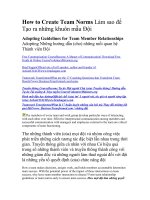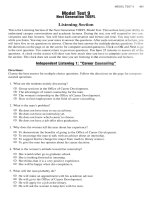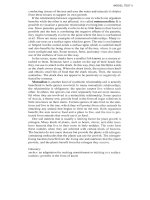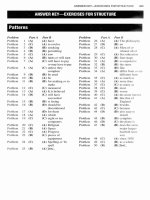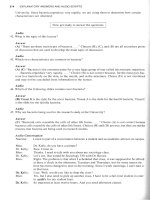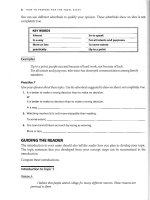How to IELTS Reading
Bạn đang xem bản rút gọn của tài liệu. Xem và tải ngay bản đầy đủ của tài liệu tại đây (3.23 MB, 14 trang )
How to prepare for IELTS – Reading
1
Contents
Page
Details of the reading test
2
The Question Types
1. Multiple choice 4
2. Short answer questions 6
3. Sentence completion questions 9
4. Notes/ table/ form/ summary/ flow chart/diagram
completion questions 11
5. Yes, no, not given or True, false, not given 14
6. Classification questions 16
7. Matching 18
8. Choosing headings 20
9. Scanning & identifying location of information 23
10. Labelling a diagram which has numbered parts 24
General tips for reading
26
Make sure you have a copy of the How to prepare for IELTS – FAQs booklet in
addition to this booklet.
How to prepare for IELTS – Reading
2
Details of the Reading Test
Procedure of the test
The reading module is the second test you do on the test day.
You are given a question booklet and an answer sheet. There is no
time, unlike in the listening test, at the end to transfer answers so you
have to write your answers directly onto the answer sheet.
You are given 60 minutes for the test.
The test instructions indicate how much time you should spend on
each section of the test.
Structure of the test
The test is divided into three sections.
You are given a reading passage with questions in each section. The
questions can be both before and after the passages.
The topics of the passages are of general interest and come from
magazines, journals, books and newspapers. At least one of the
passages will present a logical argument.
The texts increase in difficulty as the test progresses. There may be a
glossary of technical words.
Question types*
The types of tasks are:
1. Multiple Choice
2. Short-answer questions
3. Sentence completion
4. Notes/table/summary flow-chart/diagram completion
5. Yes, no, not given or True, false, not given
6. Classification
7. Matching lists/phrases
8. Choosing headings for paragraphs/sections of a text
9. Scanning and identifying location of information
10. Labelling a diagram which has numbered parts
There are 40 questions in total. Each of the three sections has around
10-15 questions and there are at least two types of questions in each
section.
*See the page 3 onwards for details on the task types, suggested
strategies for doing them and suggestions on how to get practice.
How to prepare for IELTS – Reading
3
Marking
You are given a mark for each of the 40 questions. Your result is
converted into a score which corresponds to one of the bands from 1-9.
You will see the band on your result sheet. You can be awarded a whole
band or a half band for the reading section. (See IELTS Handbook: p.20
or Focus on IELTS: p.7 for details.)
How to prepare for IELTS – Reading
4
The Question Types
1. Multiple Choice
The Questions
There are three types of multiple choice questions in the IELTS reading
exam.
Type 1. Where there is one possible answer.
Type 2. Where there are multiple answers for only one mark.
Type 3. Where there are multiple answers and one mark for each.
For these questions you may be given the start of a sentence which you
have to complete with one out of four choices. Or you may be
presented with a question and asked to find two, three or four items
in a list of answers.
You could be asked to identify facts or opinions in the texts.
Multiple choice questions can test both your global understanding of
the text or ask you for specific information. This means you will have
to make the decision yourself whether to skim or scan the text.
Look at the 3 examples below.
Type 1
Questions 1-3
Choose the appropriate letters A-D and write them in boxes 1-3 on your answer sheet.
1 According to information in the text, asparagine
A is poisonous.
B can cause cancer.
C is harmless unless heated.
D should only be eaten in small amounts.
2 According to information in the text, acrylamide
A has been found in lots of fried food.
B has been found in snacks in Sweden.
C is only found in western cooking.
D is in water.
3 According to information in the text, process foods
A should be avoided.
B are cheaper.
C are full of chemicals.
D are the most tasty foods.
How to prepare for IELTS – Reading
5
Type 2
Question 4
Write TWO letters A-F in box 4 on your answer sheet.
4 Which TWO examples of food is asparagine found in?
A peanuts
B rice
C French fries
D asparagus
E chocolate
F bananas
Type 3
Questions 5 - 7
The list below gives some of the problems for dieters raised by Dr Jones.
Which THREE of these problems are mentioned by the writer of text?
A Accessible junk food.
B Coffee bars and after-work drinks.
C Partners.
D Stress & emotional situations.
E Saboteurs and false friends.
F Weakened resolve.
Also note that you may be asked to circle ONE, TWO, THREE or FOUR letters.
How to do the multiple choice questions
• Read the instructions carefully and check how many letters you
need to circle.
• Skim all the questions and the answer choices quickly. As you do
this,
underline the key words (the words that give you the most
information).
try to get an idea of the topic you will be reading about from the
vocabulary of the questions.
look at any illustrations or diagrams that go with the text.
How to prepare for IELTS – Reading
6
• Go back to the first question. Decide if you are looking for specific
information or whether the question requires you to understand the
whole text . Then either scan or skim the text, as appropriate, to find
the answer.
• Read the relevant part of the text very carefully.
• Don’t leave any questions unanswered.
Remember
to read the stem or question carefully.
to eliminate unlikely answers.
Practice
Books in the SAC
Do as many of the following multiple choice questions as you can:
Focus on IELTS: p.45, p.73, p.91
*IELTS Preparation & Practice (R&W): pp.7-8, p.20, pp.29-30, p.41
Cambridge IELTS 1: p.26-27
Cambridge IELTS 2: p.40, p.44, p.89.
Cambridge IELTS 3: 21, p.46, p.71, p.90, p.95.
*recommended
Websites
Holmesglen Institute of TAFE
/>From the homepage go to reading and download the sample reading text
& select the multiple choice exercise.
2. Short answer questions
The Questions
There are two types of short answer questions in the IELTS reading
exam.
Type 1. Questions
Type 2. Lists
These questions will usually tell you to write your answers in NO MORE
THAN THREE WORDS. So you can answer with one word, two words
How to prepare for IELTS – Reading
7
or three words but no more. However, this is not always the case, so
check the rubric carefully.
For these questions, like the multiple choice questions, you have to
apply both skimming and scanning techniques.
Also note that the answers should not require a hyphenated word (e.g.
non-smoker ) or a contraction (e.g. They’ve).
If the answer requires a number, you can write it as a numeral (e.g. 6)
or a word (e.g. six) or a combination of a numeral and a word(e.g. 6
million).
Look at the 2 examples below.
Type 1
Questions 1 and 2
Write NO MORE THAN THREE WORDS, answering the
following questions.
Write your answers in boxes 1 and 2 on your answer sheet.
1 How old was Spencer when he did his first degree?
2 Which teacher was instrumental in Spencer’s success?
Type 2
Questions 3 - 5
List FOUR reasons for Spencer being a child prodigy.
Write NO MORE THAN THREE WORDS for each answer.
Write your answers in boxes 3-5 on your answer sheet.
3 ……………………………………………….
4 ……………………………………………….
5 ………………………………………………..
How to prepare for IELTS – Reading
8
How to do short answer questions
• Read the instructions carefully.
• Skim all the questions quickly. As you do this:
underline the key words.
decide what information you need to find in the text.
look out for question words like ‘where’ and ‘who’ which indicate
you should listen for specific things like places and people.
• Go back to the first question and decide what part of the text you
need to read.
• Read the part carefully to find the answer.
• You may use your own words. You don’t have to write a complete
sentence but it does have to be grammatically correct.
Remember
if you don’t know the meaning of any of the words in the questions, look at
the other questions. They might have some associated vocabulary in them to
help you guess the meaning.
the answer could be one word, two words or three words but not four or
more.
if you think you need more than three words your answer is probably
incorrect.
Practice
Books in the SAC
Do as many of the following short answer questions as you can:
Focus on IELTS: p.36, p.66, p.114, p.169
Cambridge IELTS 2: p.8, p.11, p.32, p.78
Websites
Holmesglen Institute of TAFE
/>From the homepage go to reading and download the sample reading text
& select the short answer questions.
How to prepare for IELTS – Reading
9
3. Sentence completion questions
The questions
There are two types of sentence completion questions in the reading
exam.
Type 1. With a selection of possible answers.
Type 2. Without a choice of possible answers.
These questions require you to complete the end of a sentence.
The questions appear in the same order as the information in the text.
Type 2 questions are similar to the short answer questions in that they
will always tell you to write your answers in NO MORE THAN THREE
WORDS. So you can answer with one word, two words or three words
but not more. They will also tell you to use words from the reading
passage.
As with short answer questions:
Also note that the answers should not require a hyphenated word (e.g.
non-smoker) or a contraction (e.g. They’ve). Also, if the answer requires
a number, you can write it as a numeral (e.g. 6) or a word (e.g. six) or a
combination (e.g. 6 million).
Look at the example below and the one on the next page.
Type 1
Questions 1 – 3
Complete each of the following statements (Questions 1-3) with the best ending A-F from the box below.
Write the appropriate letters A-F on our answer sheet.
1 Incorporating organic and inorganic matter
2 Spent mushroom compost
3 Adding potassium regularly
A makes the soil more alkaline.
B will help to encourage flowering and
fruiting.
C makes roots stronger.
D encourages vigorous growth.
E will help hold moisture in the soil.
F will improve aeration.
